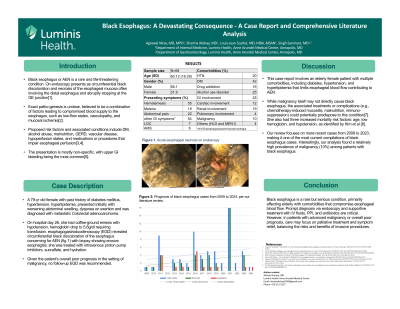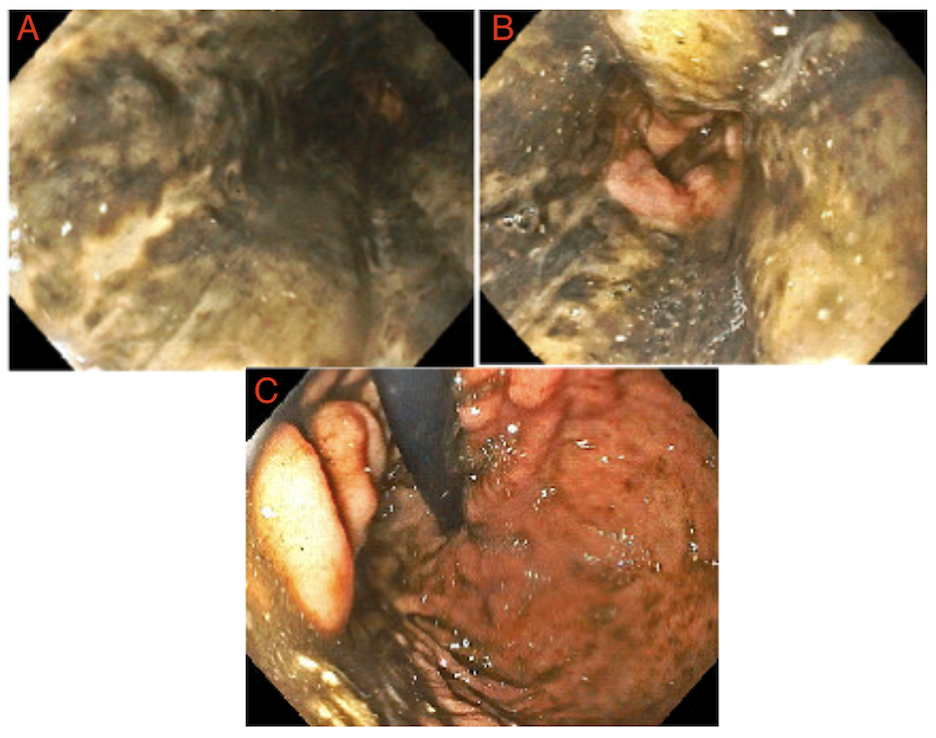Monday Poster Session
Category: Esophagus
P2251 - Black Esophagus: A Devastating Consequence - A Case Report and Comprehensive Literature Analysis
Monday, October 28, 2024
10:30 AM - 4:00 PM ET
Location: Exhibit Hall E

Has Audio

Nirav Agrawal, MD, MPH
Luminis Health/ Anne Arundel Medical Center
Pasadena, MD
Presenting Author(s)
Nirav Agrawal, MD, MPH1, Akshay Sharma, MD2, Scarlet Louis-Jean, MD, MBA, MSAN3, Steven Fleisher, MD4, Sanmeet Singh, MD3
1Luminis Health/ Anne Arundel Medical Center, Pasadena, MD; 2Annapolis, MD; 3Luminis Health, Annapolis, MD; 4Luminis Health Anne Arundel Medical Center, Annapolis, MD
Introduction: Acute esophageal necrosis, commonly known as "black esophagus," is a rare and potentially life-threatening condition characterized by circumferential black discoloration and necrosis of the esophageal mucosa. This report presents a case of black esophagus in a 79-year-old female with metastatic cancer and a review of the literature on this condition.
Case Description/Methods: A 79-year-old female with multiple comorbidities, including diabetes mellitus, hypertension, and hyperlipidemia, presented with upper gastrointestinal bleeding. Endoscopic evaluation revealed circumferential black discoloration of the esophagus, consistent with acute esophageal necrosis. The patient had advanced metastatic cancer with a poor prognosis and was managed with supportive care, including intravenous fluids, proton pump inhibitors, and sucralfate. Given her overall poor prognosis, no further interventions or follow-up endoscopy were pursued, and the patient was transitioned to hospice care.
A comprehensive review of the literature on black esophagus was conducted, including 68 cases from recent years. The mean age of patients was 60.37 years, with a male predominance (67%). Common presenting symptoms were hematemesis (55%), gastrointestinal symptoms (54%), and melena (19%). Significant comorbidities included diabetes mellitus (42%), alcohol use disorder (25%), and gastrointestinal conditions (25%). Malignancy was observed in 10% of cases. Age, low hemoglobin, and hypotension were identified as factors associated with increased mortality.
Discussion: Acute esophageal necrosis is a rare condition often associated with advanced age, comorbidities, and compromised vascular supply. Prompt diagnosis and management are crucial, with supportive care being the mainstay of treatment. In cases of advanced malignancy or poor prognosis, management may be tailored toward symptom control and palliation, considering the risks and benefits of invasive interventions.

Note: The table for this abstract can be viewed in the ePoster Gallery section of the ACG 2024 ePoster Site or in The American Journal of Gastroenterology's abstract supplement issue, both of which will be available starting October 27, 2024.
Disclosures:
Nirav Agrawal, MD, MPH1, Akshay Sharma, MD2, Scarlet Louis-Jean, MD, MBA, MSAN3, Steven Fleisher, MD4, Sanmeet Singh, MD3. P2251 - Black Esophagus: A Devastating Consequence - A Case Report and Comprehensive Literature Analysis, ACG 2024 Annual Scientific Meeting Abstracts. Philadelphia, PA: American College of Gastroenterology.
1Luminis Health/ Anne Arundel Medical Center, Pasadena, MD; 2Annapolis, MD; 3Luminis Health, Annapolis, MD; 4Luminis Health Anne Arundel Medical Center, Annapolis, MD
Introduction: Acute esophageal necrosis, commonly known as "black esophagus," is a rare and potentially life-threatening condition characterized by circumferential black discoloration and necrosis of the esophageal mucosa. This report presents a case of black esophagus in a 79-year-old female with metastatic cancer and a review of the literature on this condition.
Case Description/Methods: A 79-year-old female with multiple comorbidities, including diabetes mellitus, hypertension, and hyperlipidemia, presented with upper gastrointestinal bleeding. Endoscopic evaluation revealed circumferential black discoloration of the esophagus, consistent with acute esophageal necrosis. The patient had advanced metastatic cancer with a poor prognosis and was managed with supportive care, including intravenous fluids, proton pump inhibitors, and sucralfate. Given her overall poor prognosis, no further interventions or follow-up endoscopy were pursued, and the patient was transitioned to hospice care.
A comprehensive review of the literature on black esophagus was conducted, including 68 cases from recent years. The mean age of patients was 60.37 years, with a male predominance (67%). Common presenting symptoms were hematemesis (55%), gastrointestinal symptoms (54%), and melena (19%). Significant comorbidities included diabetes mellitus (42%), alcohol use disorder (25%), and gastrointestinal conditions (25%). Malignancy was observed in 10% of cases. Age, low hemoglobin, and hypotension were identified as factors associated with increased mortality.
Discussion: Acute esophageal necrosis is a rare condition often associated with advanced age, comorbidities, and compromised vascular supply. Prompt diagnosis and management are crucial, with supportive care being the mainstay of treatment. In cases of advanced malignancy or poor prognosis, management may be tailored toward symptom control and palliation, considering the risks and benefits of invasive interventions.

Figure: Esophagogastroduodenoscopy (EGD) revealing circumferential black discoloration of the esophagus concerning for acute necrotic esophagus (black esophagus)
Note: The table for this abstract can be viewed in the ePoster Gallery section of the ACG 2024 ePoster Site or in The American Journal of Gastroenterology's abstract supplement issue, both of which will be available starting October 27, 2024.
Disclosures:
Nirav Agrawal indicated no relevant financial relationships.
Akshay Sharma indicated no relevant financial relationships.
Scarlet Louis-Jean indicated no relevant financial relationships.
Steven Fleisher indicated no relevant financial relationships.
Sanmeet Singh indicated no relevant financial relationships.
Nirav Agrawal, MD, MPH1, Akshay Sharma, MD2, Scarlet Louis-Jean, MD, MBA, MSAN3, Steven Fleisher, MD4, Sanmeet Singh, MD3. P2251 - Black Esophagus: A Devastating Consequence - A Case Report and Comprehensive Literature Analysis, ACG 2024 Annual Scientific Meeting Abstracts. Philadelphia, PA: American College of Gastroenterology.

